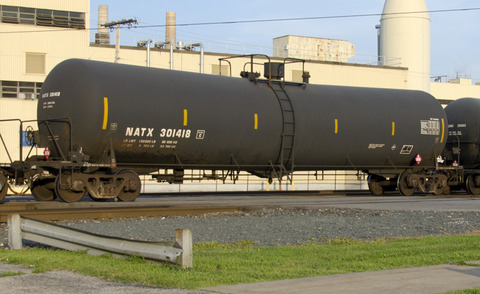
Oil Industry Wilfuly Misleads Over Crude by Rail Safety
The oil industry’s public relations arm, the American Petroleum Institute (API), has reached new lows in its attempts to twist the on-going debate about the safety of crude-by-rail trains in the US.
 The oil industry’s public relations arm, the American Petroleum Institute (API), has reached new lows in its attempts to twist the on-going debate about the safety of crude-by-rail trains in the US.
The oil industry’s public relations arm, the American Petroleum Institute (API), has reached new lows in its attempts to twist the on-going debate about the safety of crude-by-rail trains in the US.
The API is trying to claim that there is no evidence that Bakken crude is inherently more flammable than normal crude.
In its deadly misinformation campaign, the API is ignoring the growing litany of accidents across the North American network in part caused by the growth in the amount of shale oil being transported, but also in part due to the inherent flammability of Bakken crude, which makes up roughly 70 percent of U.S. crude-by-rail traffic.
Since last year’s deadly Lac-Mégantic oil train derailment in Canada, which killed 47 people, dozens of crude-by-rail trains have derailed, five of which have resulted in explosions.
Such has been the growth of crude-by-rail since the shale boom started that it is estimated that at any one moment there is a staggering 9 million barrels of crude oil moving over the rail lines of North America.
The API is also ignoring the scientific advice issued in January this year by the Pipeline and Hazardous Materials Safety Administration (PHMSA), which advised that recent explosions “indicate that the type of crude oil being transported from the Bakken region may be more flammable than traditional heavy crude oil.”
A month later, the Wall Street Journal also weighed into the debate, arguing that “Crude oil from North Dakota’s Bakken Shale formation contains several times the combustible gases as oil from elsewhere …raising new questions about the safety of shipping such crude by rail across the U.S”.
Last week the Department of Transportation tried to answer these urgent safety questions when it proposed new regulations for crude-by-rail trains, which included, among other things, the correct classification of transported fuels, reduced travel speeds for trains carrying high-hazard flammable materials; and new standards for tank cars built after October 2015.
The older DOT-111 tank car, the work-horse of the American crude-by-rail industry, would also have to be retrofitted to comply with new safety standards or banned from transporting flammable Bakken crude oil. As there are currently some 100,000 currently in use, this means that potentially tens of thousands could be decommissioned if not retrofitted in time.
Speaking last week, the US Transportation Secretary, Anthony Foxx, argued that the proposed rules amounted to a “new world order.”
“If America is going to be a world leader in producing energy, our job at this Department is to ensure that we’re also a world leader in safely transporting it,” he said.
Meanwhile the oil industry’s response has showed a callous disregard for the safety of communities across America who are on the front line of rail safety.
“The best science and data do not support recent speculation that crude oil from the Bakken presents greater than normal transportation risks,” API President Jack Gerard said. “Multiple studies have shown that Bakken crude is similar to other crudes.”
Moreover, not only did the API deny that Bakken crude was more flammable, but working with the Association of American Railroads (AAR), they argued there should be an even longer phase-out period for the DOT-111s and no requirement for either lower train speeds or mandatory stabilization for volatile kinds of crude.
Meanwhile, Foxx’s statement disappointed many environmental groups which argued that DOT-111 cars should be banned immediately, with Sierra Club Director Michael Brune calling the proposals “too little, too late” with the process of reform taking far too long.
Nor is the industry’s misinformation campaign over yet. The API and AAR will also be now lobbying frantically to water down the current proposals during the 60-day public consultation period.
